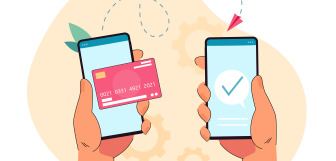How Using Mobile Payments Increases Your Business Efficiency
As a retail or hospitality business owner, you're always looking for ways to increase efficiency and reduce costs. Accepting mobile payments is a great way to do both.
The world is quickly becoming a cashless society. In the past decade, cash withdrawals have decreased significantly due to the uptake of digital payments. Besides debit and credit cards, newer alternative payment methods, such as digital wallets and mobile payments, continue to increase their market share.
So, we're giving you a complete guide on how using mobile payments can help your business become more efficient.
Let's get started.
What are mobile payments?
Mobile payments refer to any type of payment that is made using a mobile device, such as a smartphone.
This can be done in person, online, or even in-app.
There are many different types of mobile payments, but the most common are:
Digital wallets
These are payment apps that store your card details and allow you to make payments with your phone. Examples include Apple Pay, Google Pay, and Samsung Pay.
Let's say you run a cafe, and a customer wants to pay with their phone. All they need to do is hold their device up to the contactless reader, and the payment will be processed automatically. These payments are usually processed faster than card payments, so your customer will be on their way in no time.
In-app payments
These are payments made within a mobile app using your stored card details. For example, you might use this feature to buy something in an online store, or to make a booking.
Suppose you run a boutique with an eCommerce store. Your customer has found the perfect dress and wants to buy it right away. With in-app payments, they can make the purchase without having to leave the app and enter their card details again. This makes for a smoother and quicker checkout process, which your customers will appreciate.
QR code payments
These are payments made by scanning a QR code with your phone. The QR code will usually be generated by the merchant, and will contain all the necessary payment information.
Let's say you run a restaurant and a customer wants to pay their bill with their phone. You can generate a QR code for them to scan, which will take them to a payment page. They can then enter their card details and complete the transaction.
This form of mobile order and pay can be particularly useful for businesses that have a lot of customers ordering at the same time, such as cafes and food trucks.
The mobile payments trend explained
The mobile payment market is projected to grow from USD 1.97 trillion in 2021 to USD 11.83 trillion in 2028 at a CAGR of 29.1% in 2021 to 2028 [1].
There are many reasons for this trend. Firstly, contactless payments are seen as a more hygienic way to pay, which is important for limiting contagion during a pandemic.
Secondly, mobile payments are often faster than traditional methods like cash or EFTPOS. This is especially useful when there are long queues, such as at supermarkets.
Finally, many businesses now offer loyalty programs and discounts for customers who use mobile payments. This is a great way to encourage customers to use this method of payment, and it can also help you save money on transaction fees.
Satisfy more customers with fast, secure payments
- Chip and pin: Chip and pin payments reduce fraud by adding a layer of security to transactions.
-
Contactless: Offer a faster, more convenient checkout process when customers pay with contactless.
-
Remote payments: Card not present? No problem. Securely accept remote payments via link.
How mobile payments increase business efficiency
There are many benefits to using mobile payments for your business. Here are some of the ways it can help you increase efficiency and reduce costs:
Faster checkouts
Mobile payments usually take less time to process than card payments, so your customers will spend less time waiting in line. This is especially useful during busy periods, such as lunchtime rushes.
In addition, mobile payments can be processed without the need for a signature. This means that your customers can make their payment and be on their way in a matter of seconds.
Fewer queues
If you have a lot of customers wanting to pay with cash, it can cause long queues and bottlenecking at the till. This can be frustrating for both your customers and staff.
By accepting mobile payments, you can reduce waiting times and make the payment process more efficient.
Improved customer satisfaction
By making it easier for customers to pay, you can improve customer satisfaction levels and encourage repeat business. This is because customers will appreciate the convenience of being able to pay with their mobile phone.
In addition, mobile payments can help you create a better customer experience by reducing waiting times and making it easier to process orders.
Reduced costs
Mobile payments usually have lower transaction fees than card payments. This is because there are no physical card details that need to be processed.
Plus, mobile payments can help you save on paper and printing costs. This is because you won't need to print receipts for every transaction.
Improved security
Mobile payments are usually more secure than traditional methods, such as cash and cheques. This is because the payment is processed electronically and there is no need to physically exchange any money.
Mobile payments can also help to reduce the risk of fraud. This is because you can use features such as fingerprint authentication and two-factor authentication to verify the identity of the customer.
Conclusion
As you can see, using mobile payments can have many benefits for your business. It can help to increase efficiency and reduce costs, while also improving security.
If you're not already accepting mobile payments, now is the time to start.
With Epos Now Payments, you can easily start taking mobile payments. We offer a range of features to suit your business. Talk to our team of experts today.



